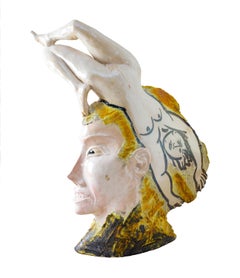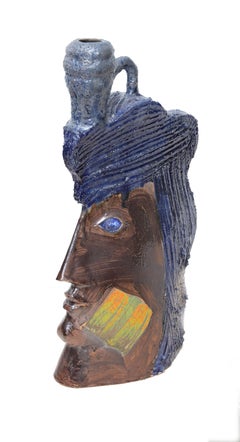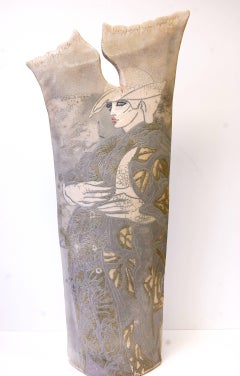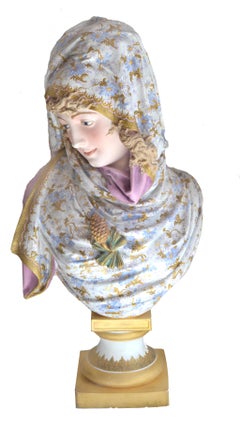Steven Kemenyffy Art
to
4
1
3
Overall Height
to
Overall Width
to
1
4
3
2
2
1
1
1
1
1
1
4
3
1
4
6,910
3,240
2,514
1,217
4
Artist: Steven Kemenyffy
'Can't Get Her Off My Mind' Ceramic Sculpture
By Steven Kemenyffy
Located in Milwaukee, WI
"Can't Get Her Off My Mind" is an original ceramic sculpture created by Steven Kemenyffy.
43"x30"x14"
Ceramic
Steven Kemenyffy (born 1943) is an American ceramic artist living and working in Pennsylvania. He is most recognized for his contributions to the development of the American ceramic raku tradition. He has served as a Professor of Ceramic Art at Edinboro University of Pennsylvania (formerly Edinboro State College) since 1969. He Has retired from teaching, but continues to produce artwork at his home studio in McKean, Pennsylvania. Kemenyffy is often characterized in regard to his contributions to American experimental ceramics of the late 1960s and early 1970s. More specifically, Kemenyffy’s contributions to American raku techniques are often cited. Kemenyffy has stated that his interest in raku came out of practical considerations: “We [Steven and Susan] were doing a variety of workshops in a variety of different media. Raku was always an official way of making pieces in a short period of time…In raku it seems to compress all the firings into one.” Kemenyffy, himself, describes his early work as “Biomorphic forms alluding to old ceramic traditions such as tiles, vases, and containers.” These works were often in excess of six feet tall and many times included mixed media elements. In 1974, Kemenyffy wrote about the work he was producing; “For several years now, my work has dealt with certain formal considerations. Chief among these is using clay in such a way as to crystallize the moment and permanentize the impermanent. These have been among the primary concerns of all potters since the earliest times.” Today, Kemenyffy continues his pursuit of biomorphic imagery and themes. He writes, “Personally I am most challenged by the business of transforming porous organics into porcelain.” For much of Kemenyffy’s career, he has worked in tandem with his wife, Susan Hale Kemenyffy. In 1987 Susan stated about their collaborative works: “Steven is the [sculptor], I am the drawer. These works would not exist if it weren’t for the sculpture; if it weren’t for the clay. The clay entity comes first and my drawings come second.” James Paul Thompson further clarifies this relationship (as observed in 1987): “Steven Kemenyffy uses patterns as a point of departure for his work, while Susan Kemenyffy...
Category
1980s Steven Kemenyffy Art
Materials
Ceramic
'History of Pottery, Africa' Ceramic Sculpture
By Steven Kemenyffy
Located in Milwaukee, WI
41x25x10"
Ceramic
Steven Kemenyffy (born 1943) is an American ceramic artist living and working in Pennsylvania. He is most recognized for his contributions to the development of the American ceramic raku tradition. He has served as a Professor of Ceramic Art at Edinboro University of Pennsylvania (formerly Edinboro State College) since 1969. He Has retired from teaching, but continues to produce artwork at his home studio in McKean, Pennsylvania. Kemenyffy is often characterized in regard to his contributions to American experimental ceramics of the late 1960s and early 1970s. More specifically, Kemenyffy’s contributions to American raku techniques are often cited. Kemenyffy has stated that his interest in raku came out of practical considerations: “We [Steven and Susan] were doing a variety of workshops in a variety of different media. Raku was always an official way of making pieces in a short period of time…In raku it seems to compress all the firings into one.” Kemenyffy, himself, describes his early work as “Biomorphic forms alluding to old ceramic traditions such as tiles, vases, and containers.” These works were often in excess of six feet tall and many times included mixed media elements. In 1974, Kemenyffy wrote about the work he was producing; “For several years now, my work has dealt with certain formal considerations. Chief among these is using clay in such a way as to crystallize the moment and permanentize the impermanent. These have been among the primary concerns of all potters since the earliest times.” Today, Kemenyffy continues his pursuit of biomorphic imagery and themes. He writes, “Personally I am most challenged by the business of transforming porous organics into porcelain.” For much of Kemenyffy’s career, he has worked in tandem with his wife, Susan Hale Kemenyffy. In 1987 Susan stated about their collaborative works: “Steven is the [sculptor], I am the drawer. These works would not exist if it weren’t for the sculpture; if it weren’t for the clay. The clay entity comes first and my drawings come second.” James Paul Thompson further clarifies this relationship (as observed in 1987): “Steven Kemenyffy uses patterns as a point of departure for his work, while Susan Kemenyffy...
Category
1980s Steven Kemenyffy Art
Materials
Ceramic
Rush Limbaugh (hair parted in center, mouth open)
By Steven Kemenyffy
Located in Milwaukee, WI
31" in height roughly 12-15" wide
Ceramic
Steven Kemenyffy (born 1943) is an American ceramic artist living and working in Pennsylvania. He is most recognized for his contributions to the development of the American ceramic raku tradition. He has served as a Professor of Ceramic Art at Edinboro University of Pennsylvania (formerly Edinboro State College) since 1969. He Has retired from teaching, but continues to produce artwork at his home studio in McKean, Pennsylvania. Kemenyffy is often characterized in regard to his contributions to American experimental ceramics of the late 1960s and early 1970s. More specifically, Kemenyffy’s contributions to American raku techniques are often cited. Kemenyffy has stated that his interest in raku came out of practical considerations: “We [Steven and Susan] were doing a variety of workshops in a variety of different media. Raku was always an official way of making pieces in a short period of time…In raku it seems to compress all the firings into one.” Kemenyffy, himself, describes his early work as “Biomorphic forms alluding to old ceramic traditions such as tiles, vases, and containers.” These works were often in excess of six feet tall and many times included mixed media elements. In 1974, Kemenyffy wrote about the work he was producing; “For several years now, my work has dealt with certain formal considerations. Chief among these is using clay in such a way as to crystallize the moment and permanentize the impermanent. These have been among the primary concerns of all potters since the earliest times.” Today, Kemenyffy continues his pursuit of biomorphic imagery and themes. He writes, “Personally I am most challenged by the business of transforming porous organics into porcelain.” For much of Kemenyffy’s career, he has worked in tandem with his wife, Susan Hale Kemenyffy. In 1987 Susan stated about their collaborative works: “Steven is the [sculptor], I am the drawer. These works would not exist if it weren’t for the sculpture; if it weren’t for the clay. The clay entity comes first and my drawings come second.” James Paul Thompson further clarifies this relationship (as observed in 1987): “Steven Kemenyffy uses patterns as a point of departure for his work, while Susan Kemenyffy...
Category
1990s Steven Kemenyffy Art
Materials
Ceramic
Gray Glazed Raku Ceramic Pottery
By Steven Kemenyffy
Located in Lake Worth Beach, FL
Large Raku Glazed Ceramic Pottery Sculpture Double-Sided.
Size:49"x22"x10"
Signed and dated title.
Susan and Steven Kemenyffy Americans Susan B: 1941, Step...
Category
1980s Modern Steven Kemenyffy Art
Materials
Ceramic
Related Items
After Albert-Ernest Carrier Belleuse Bisque Plotchrome Persian Maiden
By Albert-Ernest Carrier-Belleuse
Located in Soquel, CA
Bisque bust with ploychrome enamel decorated with painted gilt and raised on a circular socle with a square plinth. After Albert-Ernest Carrier-Belleuse by Ferdinand and Bing Co. an ...
Category
Early 1900s Aesthetic Movement Steven Kemenyffy Art
Materials
Enamel
Roman 18th century terracotta model for the sculpture of San Camillo de Lellis
Located in London, GB
This remarkably fluid terracotta bozetto was made in preparation for Pietro Pacilli’s most important public commission, a large-scale marble statue of San Camillo de Lellis for the nave of St Peter’s Basilica in Rome. Expressively modelled, this terracotta sculpture is a rare and significant work made by a major Roman sculptor at a transformative moment of European sculpture. Pacilli began his working life on the great Baroque decorative projects initiated in the seventeenth century, but he found success as a restorer of ancient sculpture working to finish antiquities for a tourist market, becoming an important figure in the emergence of an archaeologically minded Neoclassicism. Pacilli trained Vincenzo Pacetti and provided important decorative work for the Museo Pio-Clementino, at the same time he is recorded restoring some of the most celebrated antiquities excavated and exported during the period.
Pacilli was born into a family of Roman craftsmen, his father Carlo was a wood carver, and Pacilli is recorded working with him on the Corsini Chapel in San Giovanni Laternao as early as 1735. In 1738 his terracotta model of Joseph and Potiphar’s Wife won the first prize in the second class of the sculpture concorso at the Accademia di San Luca, this is particularly notable as Bartolomeo Cavaceppi came third. He worked as a carver and stuccoist completing works for the churches of San Marco and SS. Trinita dei Domeniciani Spagnoli. Pacilli operated as a sculptor and restorer of antiquities from his studio at the top of the Spanish Steps, close to Santa Trinita dei Monti, where he is listed as a potential vendor to the Museo Pio-Clementino in 1770.
In 1763 Pacilli completed a silver figure of San Venanzio for the treasury of San Venanzio. He is recorded as Pacetti’s first master and it was evidently through Pacilli that he began to acquire his facility as a restorer of ancient sculpture. Pacilli, at his studio ‘poco prima dell’Arco della Regina alla Trinita dei Monti,’ exercised, what the nineteenth-century scholar, Adolf Michaelis called ‘rejuvenating arts’ on several important pieces of classical sculpture, including in 1760 the group of a Satyr with a Flute for the natural brother of George III, General Wallmoden, Hanovarian minister at Vienna. In 1765, Dallaway and Michaelis record that Pacilli was responsible for the restorations, including the addition of a new head, to the Barberini Venus which he had acquired from Gavin Hamilton. The Venus was then sold to Thomas Jenkins, who in turn passed it on to William Weddell at Newby Hall. In 1767 Pacilli exported a series of ancient busts ‘al naturale’ including portraits of Antinous, Julius Ceaser and Marus Aurelius, also a statue of a Muse and a Venus. As early as 1756 Pacilli seems to have been operating as an antiquarian, helping to disperse the collection of the Villa Borrioni. Pacilli supplied sculpture to notable British collectors, including Charles Townley, who on his first trip to Italy purchased the Palazzo Giustiniani statue of Hecate from Pacilli. Pacilli was involved with the Museo Pio Clementino from its conception, supplying busts of Julius Ceaser and a Roman Woman as well as completing stucco putti surmounting the arms of Pope Bendedict XIV to signal the entrance to the new Museo Critiano.
In 1750 Il Diario Ordinario del Chracas announced that Pacilli had begun work on a sculpture of San Camillo de Lellis for St Peter’s. Camillo de Lellis founded his congregation, the Camillians, with their distinctive red felt crosses stitched on black habits in 1591. Having served as a soldier in the Venetian army, Camillo de Lellis became a novitiate of the Capuchin friars, he moved to Rome and established a religious community for the purpose of caring for the sick. In 1586 Pope Sixtus V formerly recognised the Camillians and assigned them to the Church of Santa Maria Maddalena in Rome. Camillo de Lellis died in 1614 and was entombed at Santa Maria Maddalena, he was canonised by Benedict XIV on June 26, 1746. It was an occasion that prompted the Camillians to make a number of significant artistic commissions, including two canvases by Pierre Subleyras showing episodes from San Camillo’s life which they presented to Benedict XIV. In 1750 Pacilli was commissioned to fill one of the large niches on the north wall of the nave with a sculpture of San Camillo.
The present terracotta bozetto presumably had two important functions, to enable Pacilli to work out his ideas for the finished sculpture and at the same time to show his design to the various commissioning bodies. In this case it would have been Cardinal Alessandro Albani and Monsignor Giovan Francesco Olivieri, the ‘economo’ or treasurer of the fabric of St Peter’s. Previously unrecorded, this terracotta relates to a smaller, less finished model which has recently been identified as being Pacilli’s first idea for his statue of San Camillo. Preserved in Palazzo Venezia, in Rome, the terracotta shows San Camillo with his left hand clutching his vestments to his breast; the pose and action more deliberate and contained than the finished sculpture. In producing the present terracotta Pacilli has expanded and energised the figure. San Camillo is shown with his left hand extended, his head turned to the right, apparently in an attempt to look east down the nave of St Peter’s. The model shows Pacilli experimenting with San Camillo’s costume; prominently on his breast is the red cross of his order, whilst a sense of animation is injected into the figure through the billowing cloak which is pulled across the saint’s projecting right leg. The power of the restrained, axial contrapposto of bent right leg and outstretched left arm, is diminished in the final sculpture where a baroque fussiness is introduced to the drapery. What Pacilli’s terracotta demonstrates, is that he conceived the figure of San Camillo very much in line with the immediate tradition of depicting single figures in St Peter’s; the rhetorical gesture of dynamic saint, arm outstretched, book in hand, head pointed upwards was perhaps borrowed from Camillo Rusconi’s 1733 sculpture of St. Ignatius...
Category
18th Century Baroque Steven Kemenyffy Art
Materials
Terracotta
Balloon Dog (Blue)
By Jeff Koons
Located in Malmo, SE
Balloon Dog (Blue) 2021.
Porcelain with metallic chromatic coating
Limited edition of 69/799 ex.
Certificate of authenticity and the original box.
Incised signature, edition number, titled and dated on the underside.
Produced by Bernardaud, Limoges, France.
Jeff Koons is an American pop artist, born in York, Pennsylvania in 1955 to a mother who was a seamstress and a father who worked as an interior decorator. He is known for working with popular culture subjects and for his reproductions of banal objects. His works have sold for important amounts, including one world record auction price for a work by a living artist. Jeff Koons had an early interest in art and as a teenager he admired Salvador Dalí. He studied painting at the Maryland Institute College of Art in Baltimore and the School of the Art Institute of Chicago. As a student he met the artist Ed Paschke who became a major influence and for whom he worked as a studio assistant in the late 1970’s.
In 1977 Jeff Koons moved to New York City where he worked at the Museum of Modern Art whilst establishing himself as an artist. In the 1980’s he began working as a Wall Street commodities broker in order to finance his art projects. He wanted to be independent from the art market and has expressed that: ”I could make exactly what art I wanted to make. And I would always know that I didn’t need the art market.”
In the mid-1980’s Jeff Koons gained prominence and recognition as part of a generation of artists who explored the meaning af art in a media-saturated era. He set up a factory-like studio in a SoHo loft with over 30 assistants.
Since his first solo exhibition in 1980 Jeff Koon’s work has been shown in major galleries and institutions throughout the world. His work was the subject of a major exhibition organized by the Whitney Museum of American Art, Jeff Koons: A Retrospective in 2014, which traveled to the Centre Pompidou Paris and then further to Guggenheim Bilbao in 2015. His most recent series, Gazing Ball Paintings, was exhibited for the first time at Gagosian Gallery, New York in 2015.
The artist has earned renown for his public sculptures, such as the monumental...
Category
2010s Pop Art Steven Kemenyffy Art
Materials
Metal
Pablo Picasso, Visage Brun-Bleu (Ramie 2), White Earthenware Clay Plate 1947
By Pablo Picasso
Located in Long Island City, NY
Created in 1947, this early Picasso ceramic is the second that artist ever produced. It is in wonderful condition and presented in a fine black wood fra...
Category
1940s Modern Steven Kemenyffy Art
Materials
Glaze, Clay
Tête de Faune, Picasso, Unique work, 1960's, Terracotta, Tiles, Design, Sculptur
By Pablo Picasso
Located in Geneva, CH
Tête de Faune, Picasso, Unique work, 1960's, Terracotta, Tiles, Design, Sculptur
Tête de faune
Unique work
14.03.1961
Painted and glazed terracotta tile...
Category
1960s Post-War Steven Kemenyffy Art
Materials
Terracotta
H 5.91 in W 5.91 in D 0.6 in
White Swimmer - Modern Unique Handmade Glazed Ceramics Sculpture , Man Portrait
By Tomasz Bielak
Located in Salzburg, AT
The sculpture is signed below, inside
Tomasz Bielak born in Lublin in 1967. He graduated of The Academy of Fine Arts, Painting and Graphics Design Department in Gdańsk, in 1994. He realized installation art, graphics press, large format murals, sculpture and painting.
In all these areas, in addition to artistic workshop, the most important thing is his message of the work, the message contained therein.
He believe that "art" is one of many languages (perhaps even more sophisticated than others) that humanity learned to lead the discourse at a level different than just verbal.
He indentify with the principle "if you have nothing to say - be quiet...
Category
2010s Contemporary Steven Kemenyffy Art
Materials
Ceramic
H 7.68 in W 7.49 in D 5.12 in
Mini-monde, sur la route
Located in LE HAVRE, FR
Ceramics and resin figurines.
Unique piece
Height: 32 cm, 12,6 in
Length: 16 cm, 6,3 in
Signed on the base.
Work sold with invoice and certificate of ...
Category
2010s Modern Steven Kemenyffy Art
Materials
Ceramic, Synthetic Resin
Hibou aux ailes déployées (Owl with spread wings), 1957
By Pablo Picasso
Located in Palo Alto, CA
Created in 1975, this madoura turned round dish of red earthenware clay, engobe decoration in black and knife engraving is from the edition of 200 and stamped with the 'MADOURA PLEIN FEU' and 'EDITION PICASSO' pottery stamps on the back.
Pablo Picasso ceramic Hibou aux ailes déployées (Owl with spread wings), 1957 A.R. 397 features a smiling owl with wings opening above its head. The owl sits on a thin branch that spans the lower length of the plate, extending the scene beyond the bounds of the ceramic. Beautiful, bushy feathers fan out. Picasso uses...
Category
1950s Modern Steven Kemenyffy Art
Materials
Ceramic
Segementados / Segments
By Arozarena De La Fuente
Located in Mexico City, MX
"Segments"
These come in three different sizes:
Large- diameter 50 cm
Medium- 29 cm
Small- 14.5 cm
XSmall- 9 cm
They are all hand made and manufactured in Mexico City. A special si...
Category
2010s Modern Steven Kemenyffy Art
Materials
Ceramic, Clay, Gesso, Acrylic
Tête de chèvre de profil (Goat's Head in Profile)
By Pablo Picasso
Located in Palo Alto, CA
Created in 1952, Tête de chèvre de profil (Goat’s Head in Profile) 1952 A.R. 145, is a Madoura oblong dish of white earthenware clay with deco...
Category
1950s Modern Steven Kemenyffy Art
Materials
Ceramic
Sancai-Glazed Horse with Cut Fur Blanket
Located in Palm Desert, CA
A Chinese, Tang Dynasty, Sancai-glazed, three colors of brown, green and creamy, sculpture of a horse with a cut fur blanket. This Chinese, Tang Dynasty (618-907 AD), glazed earthenw...
Category
15th Century and Earlier Steven Kemenyffy Art
Materials
Earthenware, Glaze
“Adam and Eve”
Located in Southampton, NY
Very rare Art Deco three dimensional terracotta sculpture of Adam and Eve by the Austrian artist, Virgil Rainer. Hand painted by the artist. Signed bott...
Category
1920s Art Deco Steven Kemenyffy Art
Materials
Terracotta, Plaster
Steven Kemenyffy art for sale on 1stDibs.
Find a wide variety of authentic Steven Kemenyffy art available for sale on 1stDibs. You can also browse by medium to find art by Steven Kemenyffy in ceramic and more. Much of the original work by this artist or collective was created during the 20th century and is mostly associated with the modern style. Not every interior allows for large Steven Kemenyffy art, so small editions measuring 12 inches across are available. Customers who are interested in this artist might also find the work of Stanley Bleifeld, Curtis Jeré, and Suzan Etkin. Steven Kemenyffy art prices can differ depending upon medium, time period and other attributes. On 1stDibs, the price for these items starts at $2,500 and tops out at $14,500, while the average work can sell for $8,213.





